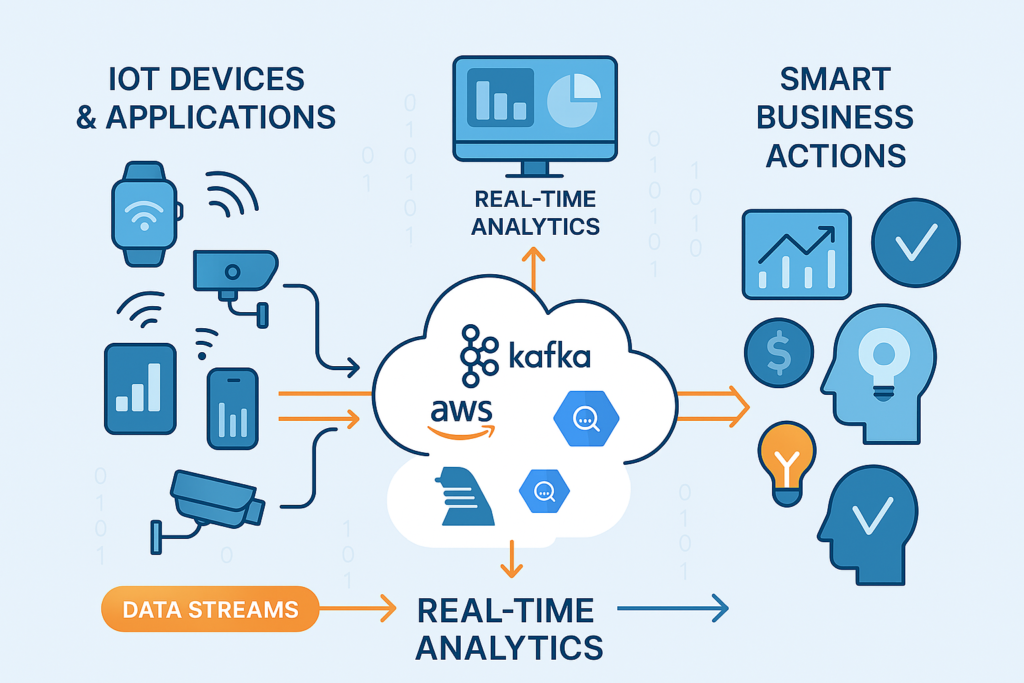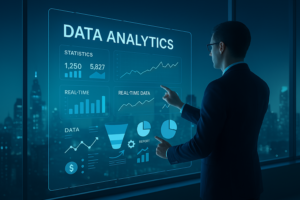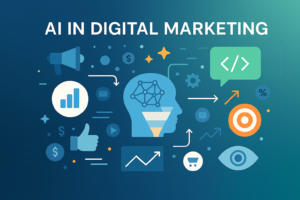
Introduction
Competitive success in modern fast-paced digital economy is determined by one’s capacity to act quickly. Real-time data analytics is now a strategic requirement rather than a sci-fi idea. Real-time analytics enables companies to react quickly and wisely to everything from supply chain adjustments to customer behavior monitoring.
This blog examines how real-time analytics turns live data into insights that may be put to use to boost customer pleasure, increase efficiency, and inform wise business decisions. Understanding the potential of real-time data analytics could be the secret to your next big success, regardless of your industry—retail, healthcare, or finance.
What is Real-Time Data Analytics
The process of gathering, processing, and evaluating data as soon as it is produced is known as real-time data analytics. Real-time analytics allows for instantaneous insights and action, in contrast to typical batch processing, which examines previous data after a delay.
The Significance of It
For industries that depend on current information, real-time analytics is essential:
Retail: Optimize product recommendations by real-time understanding of customer behavior.
Healthcare: Keep an eye on patients’ vitals and notify personnel of any emergencies.
Finance: Spot fraudulent activity as soon as it happens.
70% of enterprises will go from big data to small and wide data for real-time context-aware decision-making by 2025, per a Gartner analysis. This change highlights the increasing demand for contextual, real-time data rather than static summaries.
Real-time analytics’ advantages
Real-time analytics implementation offers numerous corporate benefits, including:
Enhanced Ability to Make Decisions
Get immediate information to help you make better, quicker decisions.
Improved Experiences for Customers
Customize consumer encounters according to their present preferences and behaviors.
Quicker Reaction Times
As opportunities or threats arise, recognize them and take appropriate action.
An advantage over competitors
Quickly adjust to market developments to stay ahead of the competition.
Efficiency in Operations
Automate processes to cut down on delays in important corporate operations.
Mitigation of Risk
Find irregularities and possible problems before they become more serious.
How Real-Time Analytics Transform Business Decisions
Let’s explore how real-time analytics is revolutionizing various industries:
Retail: Personalized Shopping Experiences
Brands like Amazon and Walmart use real-time analytics to monitor browsing behavior and deliver personalized product suggestions on the spot. This not only increases conversions but also boosts customer satisfaction.
“Real-time recommendations can increase sales by up to 35%.” – McKinsey & Company
Healthcare: Patient Monitoring and Emergency Response
Hospitals use real-time data from wearable devices and monitoring systems to alert caregivers about changes in patient vitals. This ensures rapid intervention, improves outcomes, and saves lives.
Case in Point: The Mayo Clinic uses real-time dashboards to monitor ICU patients, reducing critical response time by 40%.
Finance: Fraud Detection and Instant Alerts
Banks and fintech companies use real-time analytics to detect suspicious transactions and trigger fraud prevention protocols instantly.
Example: PayPal uses streaming analytics to process over 1,200 events per second, identifying fraudulent activities in milliseconds.
Manufacturing & Supply Chain: Predictive Maintenance
Real-time IoT sensors help manufacturers monitor machine performance. Predictive maintenance alerts reduce downtime and avoid costly repairs.
Tools and Technologies for Real-Time Analytics

Here’s a quick overview of popular tools used for real-time data analytics:
| Tool/Platform | Description |
|---|---|
| Apache Kafka | A distributed streaming platform for building real-time data pipelines and applications. |
| Apache Flink | Enables real-time stream processing with low latency and high throughput. |
| Google BigQuery | A serverless, scalable data warehouse with built-in real-time analytics capabilities. |
| Microsoft Azure Stream Analytics | Real-time event processing engine for complex event patterns in data streams. |
| AWS Kinesis | Real-time data streaming and analytics service offered by Amazon Web Services. |
| Tableau with Live Data Connectors | Enables live dashboard visualizations for data-driven decisions. |
| Snowflake | Cloud data platform supporting real-time and batch analytics in a scalable environment. |
Challenges of Implementing Real-Time Analytics
Despite its potential, implementing real-time analytics is not without challenges:
1. High Infrastructure Costs
Setting up a real-time system may require scalable cloud solutions, edge computing devices, or upgraded networks, which can be expensive.
Solution: Start with hybrid systems that allow for phased implementation or explore analytics-as-a-service providers.
2. Data Security & Compliance
Processing live data, especially from customers, raises privacy and compliance concerns.
Solution: Implement end-to-end encryption, access control, and compliance frameworks like GDPR or HIPAA.
3. Data Overload
Real-time data streams can overwhelm teams if not filtered or contextualized properly.
Solution: Use AI and machine learning models to prioritize signals over noise and alert only on critical metrics.
4. Skills Gap
Real-time analytics requires expertise in data engineering, machine learning, and cloud infrastructure—skills not all businesses readily have.
Solution: Invest in staff training or partner with analytics service providers.
Conclusion
Businesses are being able to shift from reactive to proactive, from assumptions to insights, and from making lagging decisions to leading ones thanks to real-time data analytics. Real-time analytics may help you make better decisions more quickly, whether your goal is to increase consumer engagement, lower operating expenses, or stop dangers before they happen.






